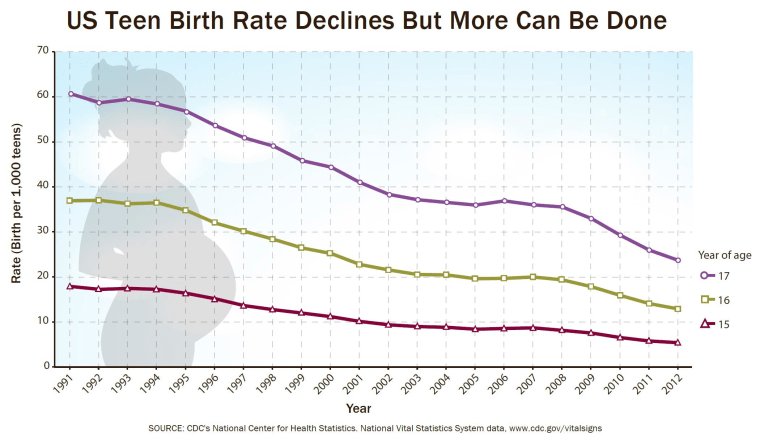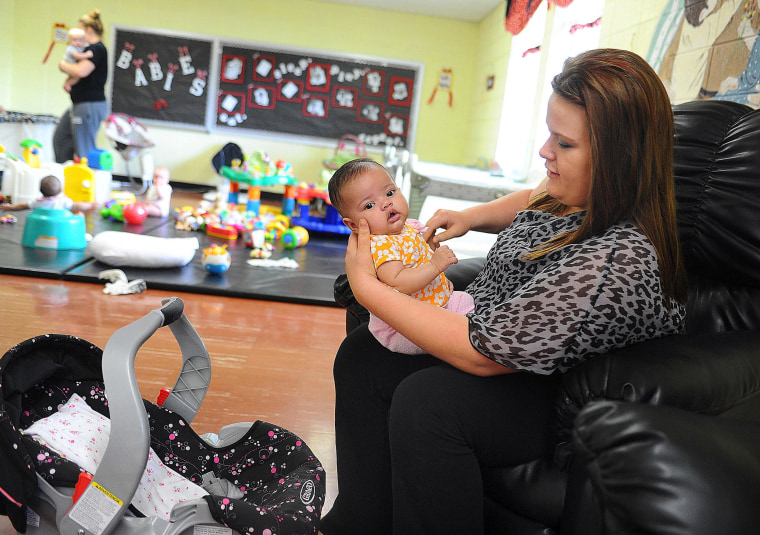The number of young teens having babies has plummeted by two-thirds since 1991, but still, 1,700 girls aged just 15 to 17 deliver babies every week in the U.S., federal officials reported Tuesday.
Why? Ignorance, mostly — they’re not talking to their parents, they're not being properly educated about birth control and when they do try to use it, they use the least effective methods, such as condoms alone, the Centers for Disease Control and Prevention said.
There are giant state-by-state differences in the birth rates, as well as ethnic differences, showing that good education and good parenting can help keep young girls safe from pregnancy, CDC experts said. Failed abstinence-only programs in states such as Texas and Mississippi are helping keep those states at the very top of the teen birth rate list, other experts said.
“Although we have made significant progress reducing teen pregnancy, far too many teens are still having babies,” CDC Director Dr. Tom Frieden said.
The report is one of several lately to show a record low in teen births by various measurements.
"Far too many teens are still having babies."
For this one, the CDC used the National Survey of Family Growth, a large, ongoing, in-person survey of thousands of Americans.
The good news is that the rate of births per 1,000 teens aged 15 to 17 has fallen by 63 percent since 1991, from 38.6 per 1,000 teens to 14.1 per 1,000 girls in 2012.
“Most teens aged 15-17 (73 percent) had not had sex yet,” CDC officials wrote.
The bad news is that still means more than 86,000 girls aged 15 to 17 had babies in 2012. And nearly one in four of the younger teens said they never spoke with their parents or guardians about sex, CDC found. Just 1 percent of the teenagers who said they had sex used the most effective methods to prevent pregnancy, which are IUDs or implantable hormones, the survey found.
Only four out of 10 said they had been given information both on how to say no to sex and about birth control. And 83 percent of the boys and girls who had sex said they had not received any sex education before their first time.

“We are missing opportunities to deliver messages before teens begin to have sex,” Lee Warner of the CDC’s division of reproductive health told reporters.
Pediatricians, teachers and parents all need to take a role, the CDC said. “We as health professionals have the duty to give young people the necessary knowledge,” said Ileana Arias, CDC’s principal deputy director. “The younger teen years, that is 15 to 17, are a critical time when a young woman can jeopardize her future by not finishing high school.”
Boys are at risk, too, especially if they must go to work to support a child while they are still in school.
“Teens who give birth are at increased risk of having a repeat birth while still a teenager,” added Shanna Cox of CDC’s Division of Reproductive Health.
“Efforts to prevent teen childbearing need to focus on evidence-based approaches to delaying sexual activity and increasing use of the most effective methods of contraception for those teens who are sexually active,” Frieden said.
“Evidence-based” means programs shown to work, and these have to be comprehensive, said Elizabeth Nash of the Guttmacher Institute, which studies pregnancy and sexual behavior. She is struck by the CDC data showing Washington, D.C., New Mexico, Texas, Oklahoma, Mississippi, Arkansas and West Virginia with the very highest teen pregnancy rates, and New Hampshire, Massachusetts, Maine, Connecticut and Vermont at the bottom, with much, much lower rates.
“When you look at the bottom 10 or so you generally are seeing states that have taken an approach mostly to increase access to family planning services, to look at sex education, to have a culture that is understanding of teen sexuality and trying to provide information or resources and the education that teens need,” Nash told NBC News.
“We are talking healthy relationships, contraception and abstinence. They need to hear about all of it."
Washington, D.C., has the problem that many large cities have in fighting all sorts of battles, from teen sex to sexually transmitted infections. Many young, poor, urban boys and girls see young parenthood as a plus, and there are more opportunities for older men to have sex with young girls. Pregnancy rates are two to three times higher among Hispanic and black teens than among white teens.
New Mexico may be dealing with non-English speaking immigrants who don’t trust or understand the health care system. But the rest of the states with ultra-high teen pregnancy rates are states that have clung to restrictions on sex education in schools, Nash said.
They often have policies that make it difficult for schools to provide comprehensive sex education, Nash noted.
“We are talking healthy relationships, contraception and abstinence. They need to hear about all of it,” Nash said. “They need to know that family planning is accessible even if they are not going to be sexually active right now.”
